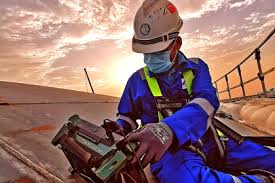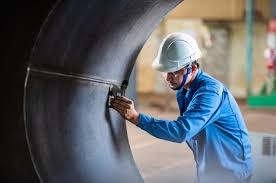Offshore NDT inspection in Egypt is a ultrasonic testing of welds critical aspect of ensuring the structural integrity of offshore installations in the region. With the rapid expansion of offshore oil and gas exploration and production activities, the need for reliable non-destructive testing (NDT) inspection services has become increasingly important. This article explores the significance of offshore NDT inspection in Egypt and its role in maintaining the safety and integrity of offshore structures at sea.
Offshore NDT inspection in Egypt plays a crucial role in ensuring the structural integrity of offshore installations such as platforms, pipelines, and vessels. These inspections are conducted using various non-destructive technology methods to detect and assess any defects or anomalies in critical structural components. By identifying and addressing potential issues, offshore NDT inspections help to prevent equipment failure, maintain operational safety, and minimize environmental impact. In Egypt, these inspections are essential for the country's offshore oil and gas industry, as well as for other marine infrastructure projects. With the non destructive testing ndt services proper implementation of NDT inspections, Egypt can continue to uphold high safety standards and ensure the reliability of its offshore structures.
The Importance of Offshore NDT Inspection in Egypt

Offshore NDT inspection in Egypt is of great importance for ensuring the safety and integrity of offshore structures such as oil platforms, pipelines, and subsea equipment. Non-destructive testing (NDT) is essential for identifying and evaluating defects or inconsistencies in materials and welds without causing damage to the structure being inspected. Offshore NDT inspection helps to detect potential issues before they escalate into major problems, which could lead to accidents, environmental damage, and costly repairs. This is especially critical in Egypt, where the offshore oil and gas industry plays a significant role in the country's economy. Moreover, conducting regular NDT inspections in offshore facilities helps to comply with regulatory requirements and industry standards, thus ensuring the overall safety and reliability of the infrastructure. It also provides quality assurance and ndt testing services helps to extend the lifespan of offshore assets. In conclusion, offshore NDT inspection is crucial for maintaining the safety, environmental sustainability, and operational efficiency of offshore facilities in Egypt. It is an indispensable tool for identifying and addressing potential issues, ultimately contributing to the success of the offshore oil and gas industry in the country.
Challenges and Innovations in Offshore NDT Inspection Egypt
ultrasonic testing of welds

Offshore non-destructive testing (NDT) inspection in Egypt faces several challenges, including harsh environmental conditions, such as high temperatures, humidity, and saltwater exposure, which can affect the integrity of offshore structures and equipment. Additionally, limited accessibility and the need for specialized equipment and personnel make conducting NDT inspections in offshore environments more difficult. To overcome these challenges, innovations in NDT technology and techniques are being implemented. This includes the use of advanced NDT methods such as phased array ultrasonics, guided wave testing, and remote visual inspection, which allow for more thorough and accurate inspections of offshore structures. Furthermore, robotics and autonomous underwater vehicles (AUVs) are being increasingly utilized to carry out inspections in difficult-to-reach areas, reducing the need for human divers and increasing efficiency and safety. In addition to technological advancements, there is also a growing emphasis on training and certifying NDT personnel to ensure that inspections are carried out to the highest standards. Collaboration between industry stakeholders, government agencies, and research institutions is also driving the development of best practices and standards for offshore NDT inspection in Egypt. These efforts are crucial for ensuring the safety and reliability of offshore infrastructure in the region.
Cost-Effective Solutions for Offshore NDT Inspection in Egypt

Cost-effective solutions for offshore NDT inspection in Egypt can include utilizing advanced inspection technologies such as phased array ultrasonic testing (PAUT) and eddy current testing (ECT) to efficiently and accurately assess the condition of offshore structures and equipment. Additionally, employing experienced and certified NDT inspectors who are familiar with the specific requirements and regulations in Egypt can help streamline the inspection process and minimize costs. Implementing a risk-based inspection (RBI) strategy can also ensure that resources are focused on areas of higher concern, optimizing the use of time and equipment. Finally, leveraging digital data management systems can reduce paperwork and administrative tasks, improving overall efficiency and cost-effectiveness. Overall, a combination of advanced technologies, skilled personnel, strategic planning, and digital systems can contribute to cost-effective offshore NDT inspection in Egypt.
Advancements in Offshore NDT Inspection Technology in Egypt
Offshore NDT inspection technology in Egypt has seen significant advancements in recent years. These improvements include the development of advanced robotic inspection systems capable of conducting inspections in harsh and difficult-to-reach underwater environments. Additionally, there have been innovations in the use of advanced sensors and imaging technologies for more accurate and efficient inspections of offshore infrastructure. These advancements have led to improved safety, reduced downtime, and greater overall productivity in the offshore oil and gas industry in Egypt.
Best Practices for Offshore NDT Inspection in Egypt
Offshore NDT inspection in Egypt follows best practices to ensure the safety and integrity of offshore structures. These practices include using qualified and experienced technicians, using advanced NDT equipment, complying with international standards and regulations, performing thorough inspections at regular intervals, maintaining detailed records, and conducting regular training and certification programs for inspection personnel. Additionally, it's important to ensure that the inspection process is carried out in a timely and efficient manner to minimize downtime and disruption to offshore operations. Adhering to these best practices helps to ensure the reliability and safety of offshore structures in Egypt.
Ensuring Safety and Compliance: Offshore NDT Inspection in Egypt
Offshore non-destructive testing (NDT) inspection in Egypt is a crucial aspect of ensuring the safety and compliance of offshore structures and equipment. NDT inspections are carried out to assess the structural integrity and reliability of offshore assets, such as pipelines, platforms, and subsea equipment. These inspections involve the use of advanced techniques and equipment to detect defects, corrosion, and damage that may compromise the safety and performance of offshore facilities. In Egypt, NDT inspections are conducted in accordance with international standards and regulations to ensure the integrity and reliability of offshore structures. This includes thorough documentation and reporting of inspection results, as well as adherence to industry-specific guidelines and best practices. Additionally, experienced and certified NDT inspectors are employed to carry out these inspections, ensuring that the highest standards of quality and safety are met. By conducting offshore NDT inspections in Egypt, companies can proactively identify and address potential issues before they escalate into safety or compliance risks. This helps to prevent accidents, minimize downtime, and extend the service life of offshore assets. Overall, offshore NDT inspections play a vital role in upholding safety and compliance standards in the Egyptian offshore industry.
Training and Certification for Offshore NDT Inspection in Egypt
To obtain training and certification for offshore NDT inspection in Egypt, individuals can enroll in specialized NDT training programs offered by various training institutes and organizations. These programs are designed to provide participants with the necessary knowledge and skills to conduct non-destructive testing (NDT) on offshore structures and equipment. Some of the common NDT methods covered in these programs include ultrasonic testing, magnetic particle testing, visual inspection, radiographic testing, and eddy current testing. The training typically includes both classroom instruction and hands-on practical experience to ensure participants are well-equipped to perform NDT inspections in offshore environments. After completing the training, individuals can pursue certification from recognized NDT certification bodies such as the American Society for Nondestructive Testing (ASNT) or the Certification Scheme for Personnel (CSWIP). These certifications demonstrate proficiency in NDT techniques and are often required by employers in the offshore industry. In Egypt, there are several NDT training providers and certification bodies that offer programs specifically tailored to the needs of offshore inspectors. It's important for individuals to research and select training and certification options that are accredited and recognized within the industry to ensure their qualifications are widely accepted.
